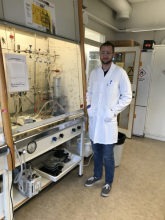
University:
Major:
Site Abroad:
Mentor(s):
Faculty Sponsor(s):
Faculty Sponsor's Department:
Project Title:
Project Description:
Renewable energy sources such as wind turbines and solar cells have been widely considered to play vital roles in the future of our energy infrastructure. Due to the current limitations associated with energy storage devices, the intermediately supplied solar cells cannot be solely relied upon to supply energy needs on a large scale quite yet. Molecular solar thermal energy storage systems (MOST) are molecules which provide a promising alternative to batteries and photovoltaics when achieving long term energy storage by utilizing their photoswitchable nature and storing the solar energy in a higher energy isomer that is metastable at ambient temperatures. This energy can then be released when needed through catalytic activation, allowing us to utilize the heat released. The catalyst used in such a process must remain insoluble and heterogenous when in solution in order to control back conversion. It also must have a fairly high rate of reaction when converting the isomer back to its parent molecule. We hope to achieve both of these requirements by studying two variations of a metal-organic framework catalyst used on multiple widely-used MOST systems. These systems are norbornadiene (NBD) / quadricyclane (QC), dihydroazulene (DHA) / vinylheptafulvene (VHF), solid trans-Azobenzene (trans-AZS) / cis-Azobenzene system (cis-AZS), and liquid trans-Azobenzene (trans-AZL) / cis-Azobenzene (cis-AZL). NMR was used to compare the spectra of samples before and after irradiation as well as after the addition of catalyst, which qualitatively showed the amount of isomers returning to their parent molecule. Quantitative data such as percent back conversion and reaction rates were determined using peak integration on NMR and fitting data acquired through UV-vis, respectively. Contour plots were fitted with time and absorbance against wavelength, which allowed us to qualitatively determine the amount of dissolution that occurred. Miniature fixed-bed reactors were coupled with UV-vis detectors to determine the percent conversion of these MOST systems.
